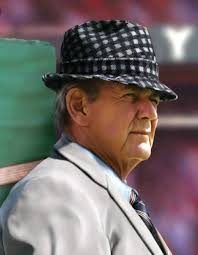ESPN’s Groundbreaking Report Declares Bear Bryant the Greatest Coach in College Football History, Solidifying Alabama’s Dynasty and Redefining the Gold Standard for Power Running Backs Across Generations
In a momentous revelation that has reverberated throughout the world of college football, ESPN has released a comprehensive report officially naming Paul “Bear” Bryant as the greatest coach in the history of college football. This unprecedented recognition not only cements Bryant’s legendary status but also shines a spotlight on the University of Alabama’s enduring dynasty and the profound influence Bryant had on shaping the archetype of the power running back — a legacy that has echoed across generations of players and coaches.
The Making of a Legend: Bear Bryant’s Coaching Career
Paul “Bear” Bryant’s coaching career is nothing short of extraordinary. Over 38 years as a head coach, Bryant amassed 323 wins, an NCAA record for decades, underscoring his consistency, resilience, and mastery of the game. His tenure at Alabama, spanning from 1958 to 1982, was especially historic — leading the Crimson Tide to six national championships and 13 Southeastern Conference (SEC) titles. His teams not only won games; they dominated, setting standards in preparation, discipline, and tactical innovation that still influence football today.
Bryant’s greatness lies in his ability to adapt and innovate. He led Alabama through significant changes in college football—from the single platoon era to modern two-platoon systems, and from run-heavy offenses to incorporating balanced attacks. Yet, throughout these changes, his teams maintained a fierce competitive edge. ESPN’s report highlights that Bryant wasn’t just a coach who won games; he was a visionary who fundamentally reshaped how college football was coached, played, and perceived.
Solidifying Alabama’s Dynasty
The University of Alabama’s football program is synonymous with excellence, and much of that legacy is built on Bryant’s shoulders. When he arrived in 1958, Alabama was a respected program but not yet a perennial powerhouse. Under Bryant’s guidance, the Crimson Tide evolved into a dominant force that intimidated opponents and captivated fans nationwide.
Bryant’s emphasis on discipline, physical toughness, and mental resilience created a culture that extended far beyond the field. The “Alabama Way” became a blueprint for success in college sports. His teams were known for suffocating defenses, powerful running games, and a relentless work ethic. This foundation paved the way for continued success at Alabama long after Bryant’s retirement in 1982.
ESPN’s analysis underscores how Bryant’s dynasty set the gold standard for what a college football powerhouse looks like: sustained success over decades, an unyielding commitment to excellence, and an ability to continuously adapt to the evolving landscape of the sport.
Redefining the Power Running Back
One of Bryant’s most profound impacts was his role in elevating the power running back to a central figure in college football offenses. In an era when many teams relied heavily on ground-and-pound football, Bryant perfected it with an emphasis on bruising, downhill running backs who could wear down defenses and control the tempo of games.
His coaching nurtured and showcased legendary backs like Johnny Musso and Wilbur Jackson, who embodied the ideal combination of size, speed, and toughness. Bryant’s offensive schemes relied on these backs not just for yardage but as weapons to dominate physically and psychologically. This philosophy influenced generations of coaches and players who aspired to emulate Alabama’s power running game.
ESPN’s report goes further, detailing how Bryant’s running backs redefined the position’s expectations—fusing raw power with agility and

